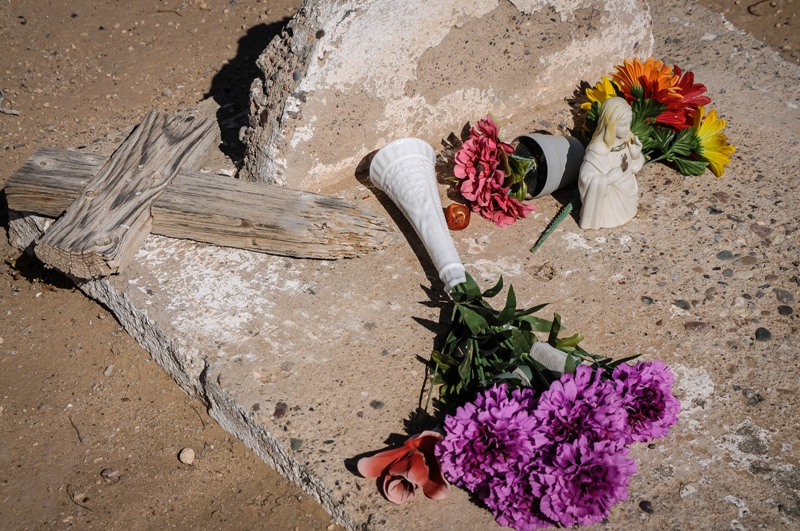(Avondale. Arizona) — In the midst of the solitude of the Goodyear Farms Historic Cemetery, there are countless of silent voices eager to narrate a story. They are the unheard but real voices of the men, women and children who are buried in this resting place for the dead ones, a graveyard that paradoxically hangs on to exist.
This story is not just the historical account of a man who came from Akron, Ohio to Arizona looking for an ideal land to grow a special type of cotton during World War I. Nor only the story about how the Arizona desert —deemed at one point a “valueless” land by a U.S. surveyor— became a rich region full of homes, businesses and farms. This is also about the still unfinished story of the peasants who with their hard labor contributed to transform an inhospitable place inhabited by scorpions and lizards and carpeted by sagebrushes and cacti into fertile and productive cotton fields.
RELATED ARTICLE
Located about 20 miles west of Downtown Phoenix and surrounded by hundreds of new homes, the Goodyear Farms Historic Cemetery —also known as Pioneer Cemetery— remains today as a vestige of an important farming era. Almost a century ago, this became a vast farmland dedicated to the cultivation of high-grade cotton used in the production of tire fabric by the Goodyear Tire and Rubber Company.
The farms gradually disappeared under the spread of housing and commercial development, leaving the cemetery enclosed within a large residential area, struggling to not vanish as the cotton fields that established it, and hanging on to Arizona’s history.
Beginnings of a pioneer cemetery
The story begins at the dawn of the incorporation of Arizona into the Union, by then the 48th state of the United States. In 1916, two years into the Great War, the emergence of the pneumatic tire and the demand for the cotton needed to produce it, forced the United States to look into its own territory to find ways on how to grow a variety known as long-staple cotton, which they couldn’t obtain anymore in the same quantities from the Sea Islands (off the coasts of the State of Georgia) due to the devastation caused by the boll weevil, and neither from Egypt, due to the activities of German submarines during the hostilities.
This situation created a challenge for the Goodyear Tire and Rubber Company and an opportunity for the new state of Arizona. The United States Department of Agriculture (USDA) had conducted experiments in the area of the Salt River Valley in Arizona, which revealed climatic conditions and soil properties similar to those in Egypt existed. The USDA urged an executive from Goodyear to travel to Arizona from Akron, Ohio to see this land for himself. Paul W. Litchfield was this man, and he concluded that the land in Arizona was indeed suitable for growing crops of the desirable long-staple cotton, analogous to Egypt’s.
To launch the ambitious and visionary farming endeavor, Litchfield established a subsidiary called The Southwest Cotton Company. Goodyear acquired thousands of acres of land and in 1917 set out to turn it into a large and successful cotton farming operation. Thus, cotton farming would eventually give this area a distinctive identity and would deeply transform it, not only geographically, but also economically and culturally. And so, cotton culture would begin shaping this area of central Arizona.
In terms of human resources, the newly formed Southwest Cotton Company recruited a legion of about 2,000 men to get the difficult job of transforming the autonomous desert into disciplined agricultural fields done. The majority of these new employees were peasants brought from the country of Mexico and some were Native Americans. Not only World War I was taking place; the Mexican Revolution (1910- 1917) was at its height. Thousands of people were migrating to the United States to escape this civil war. It is very likely that the new cotton farming operation would also attract a good share of migrants fleeing Mexico and coming to Arizona on their own at that time of revolt.
This pioneer workforce of mainly Mexican and American Indians, making use of more than one thousand mules and about a dozen gasoline-powered tractors equipped with iron wheels, set to the heavy task of leveling the fields in the challenging Arizona desert. Part of their work consisted of removing the natural desert vegetation, plowing the soil and digging irrigation canals to bring to the fields the necessary water from the Agua Fria River, flowing a few miles south. It is easy to assert these laborers worked very hard to earn the $1.00 to $2.50 a day they were paid.
About this time, Goodyear also established a place to house these farmers in a large camp that became known as Algodón (the Spanish word for cotton,) and when it was later relocated it was called Agua Fria. The entire farming area was called Litchfield Park, and the workers camp was located at the core.
The first approximately 3,500 acres of land that were prepared for the initial planting produced a reported harvest of 264,000 pounds of fine cotton in the winter of 1917-1918. The amount of cotton rose to 6,734,000 pounds of the blue-ribbon grade long-staple cotton the following year. Cotton balls were rolling.
With their hard and pioneer work, these peasants undoubtedly became an important part of the farming and economic development of Arizona, as well as contributed to the demands of war. The historical record obviously indicates the Southwest Cotton Company sought to hire cheap labor, as well as a workforce who was at easy reach and in proximity to the farming operation. Nevertheless, they hired hard-working, skillful, and adept hands.
By exporting this foreign workforce to Arizona, the Southwest Cotton Company also played a part in creating socioeconomic and labor patterns of immigration into the United States. Within the context of the current immigration debate in Arizona, and elsewhere in the United States, history can lend a hand to understand social issues like undocumented immigration in Arizona.
Ultimately, the case of Goodyear Farms further proves the historical need for migrant workers, as well as a mechanism to allow them to come to work and return home within a legal framework. Today, the Arizona Farm Bureau cites as a priority the need for a work visa reform and immigrant workers, even during the recession.
The Flu Pandemic of 1918 and the establishment of the cemetery
As World War I was in its final offensives and nearing its end, a ravaging influenza pandemic (also known as the Spanish Flu) began to spread in March of 1918 throughout the world. According to data, the majority of victims were healthy young adults. The pandemic lasted until June 1920, and it is estimated that 30 to 50 million died, and 500 million became infected by the virus. An estimated 675,000 Americans were among the dead. At the end more American citizens died from this epidemic than in World War I.
According to the United States Department of Health Services (HHS), the influenza reached Arizona in late September 1918, most likely spreading from Phoenix to the rest of the state. By the first week of November, health officials were overwhelmed as deaths due to the epidemic were four times Arizona’s annual average. After the influenza reached this peak, the fatal disease declined gradually during the late fall and early winter. By late spring 1919, the pandemic began disappearing from Arizona.
Historical data establishes that the labor camps were particularly hit hard by the pandemic due to the poor sanitation conditions that prevailed back then. In response to the number of workers and members of their families said to have died as a consequence of the pandemic, the Southwest Cotton Company set up an area in the camp to be used as a graveyard. According to HHS’s dates on when the virus appeared in Arizona, this pioneer cemetery was likely established during the last months of 1918, as it was reportedly created in response to the pandemic.
There are no known records available to determine how many Goodyear Farms’ workers who died due to the pandemic were buried in this cemetery, presently known as the Goodyear Farms Historic Cemetery or Pioneer Cemetery. The names of many of the people who were buried as well as the date of their death will probably remain unknown, as a large number of gravestones are completely unmarked today. Perhaps somewhere there is a registry that identifies human remains by location within the cemetery.
Winds of change for the pioneer cemetery
The cotton farmlands have inexorably long vanished over the years and with them the labor camps. After the Goodyear farming activities ceased, the Westinghouse Company purchased the 12,000 acres of agricultural land, including the cemetery, to conduct residential and commercial development plans.
Housing development likely wiped many possible remnants of the farming landscape that characterized this tri-city area of Avondale, Litchfield Park and Goodyear. The pioneer cemetery survived; today it remains delimited by dozens of homes in a predominant residential area.
At the present time, the Goodyear Farms Historic Cemetery is still an active cemetery, and after Westinghouse took ownership, it was assigned to the care of the Tempe, Arizona-based SunCor Development Company, a building and developing corporation. For little more than 20 years, since the property of the original Litchfield Ranch was purchased in 1987, SunCor has been running the Goodyear Farms Historic Cemetery on a non-profit basis and as a private cemetery.
Now SunCor has requested the City of Avondale government to take over and administer the cemetery. But the economic recession has also hit the City of Avondale, which also acknowledges lack of expertise in running a cemetery. Included in SunCor’s request to Avondale is a trust fund of $244,000 to run the cemetery. The City Council will decide this matter in May 2010.
“It is history here”
A small cemetery enclosed in the residential area that replaced the farms and the cotton culture doesn’t have to be a big problem. The opportunity to cherish history and reaffirm Arizona’s farming and labor roots is not buried, but at hand. The Goodyear Farms Historic Cemetery or Pioneer Cemetery is still there, it has not vanished like the cotton fields, and its history is not completely lost yet. While much work needs to be done, both the scholar and the layperson can do much to get it done.
On Saturday, April 10th, Ballet Folklorico Esperanza, an Arizona-based cultural non-profit organization promoting Mexican regional dances, held a cleanup event at the Goodyear Farms Historic Cemetery. Al Soria, who with his wife Kathi runs the dance group and helps to maintain the cemetery on a volunteer basis, said he was happy to see families from different ethnic groups showing up to help clean the cemetery.
“We put the word out to the community, ‘Hey!, it’s a historic cemetery, it has a lot of history,’ said Soria. “Nobody stopped to ask: ‘What history?’ They just said: ‘Historic, it is history here, and let’s preserve it and let’s clean it up, and be proud of it.”
Although the fate of the Goodyear Farms Historic Cemetery is still uncertain, Soria’s statement remains true, as it would surely take more to reconstruct history in the future than what it takes to preserve it today.
Related Video: Goodyear Farms Historic Cemetery in Arizona
© 2010 – 2023, Eduardo Barraza. All rights reserved.





